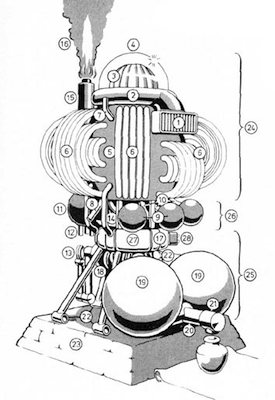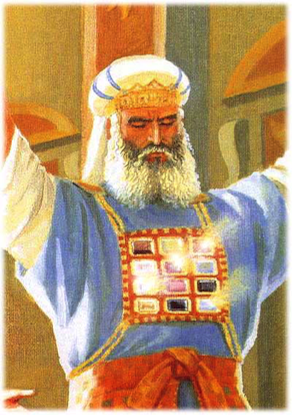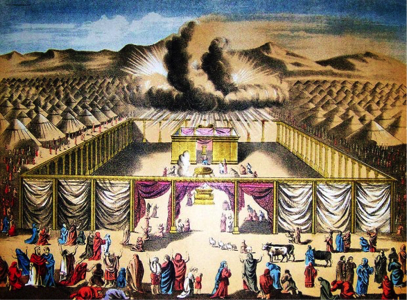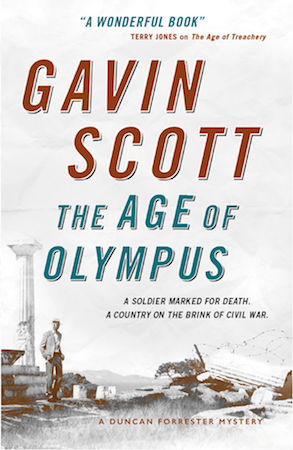One of the more mysterious characters on the island of Hydros in The Age of Olympus is Count Bohemond, who built the castle in the ruins of which one of the crucial scenes takes place.
Though there were several Count Bohemonds during the Crusades, mine is not to be found in in any official records, but the Biblical artifacts he is described as finding in Palestine and bringing to Hydros do originate in the Bible. They are the strange objects known as the Urim and the Thummim, which are first spoken of in Chapter 28 of the Book of Exodus.
“In the breastpiece of judgment you shall put the Urim and the Thummim, and they shall be on Aaron’s heart when he goes in before the LORD; thus Aaron shall bear the judgment of the Israelites on his heart before the LORD continually.”
They are also mentioned in Chapter 28 of the Books of Samuel:
“When Saul saw the camp of the Philistines, he was afraid and his heart trembled greatly. When Saul inquired of the Lord, the Lord did not answer him, either by dreams or by Urim or by prophets.”
No one knows exactly what the Urim and the Thummim looked like, but the words have traditionally been translated as lights and perfections, and Talmudic scholars, as well as the Roman-Jewish historian Josephus, say that the device was used to answer questions put to God, whose answers came in the form of rays of light shining from certain jewels on the breastplate.
One theory goes that each jewel was taken to represent different letters, and the sequence in which they lit up would spell out an answer – but in 1978, while I was working as a reporter for BBC Radio in London, two men who had recently published a book came into the studio at Broadcasting House with a much more intriguing theory. Their book was called The Manna Machine.
 George Sassoon and Rodney Dale were designers and engineers who studied the Jewish kabbalistic writings known as the Zohar. Among other things the Zohar gave a detailed description of something called “The Ancient of Days”, which some took to mean God himself. One of the Zohar’s apparently bizarre claims was that The Ancient of Days had “three heads, hollowed out, this inside that, that above the other,” and that the hairs of its beard returned to the head.
George Sassoon and Rodney Dale were designers and engineers who studied the Jewish kabbalistic writings known as the Zohar. Among other things the Zohar gave a detailed description of something called “The Ancient of Days”, which some took to mean God himself. One of the Zohar’s apparently bizarre claims was that The Ancient of Days had “three heads, hollowed out, this inside that, that above the other,” and that the hairs of its beard returned to the head.
Sassoon and Dale decided this was not, as had traditionally been assumed, metaphor, but a literal description of something, and they used their engineering skills to draw what The Ancient of Days might have looked according to the words of the Zohar. The photo to the right is what they came up with.
They gave a number to each part, and linked it to the words used in the kabbalistic writings, and also in the Bible, which said, among other things, that the Ark of the Covenant gave off a column of smoke by day and a column of fire by night.
1. the Column of Smoke by Day and the Column of Fire by Night. A Buchner pump in the exhaust produces the vacuum to process the chlorella in …
2. the Cavities of the Brain of the Small-faced One (manna processing plant). The Buchner pump is connected to the Cavities of the Brain by …
3. the Beard of the Small-faced One (vacuum pipe manifold).
4. The processed manna is stored in the Hosts (manna storage vessels)…
5. and is drawn off through the Penis (manna discharge pipe) and…
6. the Cover of the Penis (vacuum lock). The machine stands upon…
7. Legs as Columns Six (six legs with rings for carrying poles) resting on…
8. the Throne (platform of stone) which is cast down when the machine is moved. The whole machine – the Ancient of Days – may be separated into …
9. the Ancient One (top part) and…
10. the Small-faced One (bottom part). Between these two parts lie…
11. the Nakedness (interface unit) below which are…
12. the Crowns of the Small-faced One (inspection covers) and…
13. the Ear of the Small-faced One (communications unit).
 They then boldly hypothesised that the Ancient of Days was in fact a machine which had been provided to the ancient Israelites as they fled Egypt by aliens in orbit around the earth, to provide them, by processing algae, with the single-cell protein which allowed them to survive for forty years in the desert.
They then boldly hypothesised that the Ancient of Days was in fact a machine which had been provided to the ancient Israelites as they fled Egypt by aliens in orbit around the earth, to provide them, by processing algae, with the single-cell protein which allowed them to survive for forty years in the desert.
It was powered, they told me, by a nuclear reactor which produced manna for six days. On the seventh day the machine would be taken apart for cleaning – which is where the Sabbath, the holy day of rest, originated.
But what about the Urim and the Thummim? This fitted perfectly with their thesis, they said – as the communications device provided by the aliens so the Israelites could receive instructions on how to use the machine!
Altogether it was one of the most fascinating interviews we broadcast on the PM programme that year, and though my old boss George Lucas has done a lot with the Ark of the Covenant, there’s been very little fun had with that mysterious breastplate – and I decided to remedy that with the assistance of Duncan Forrester.
According to The Age of Olympus, then, the Urim and the Thummim were found in Jerusalem during the Crusades by Count Bohemond and brought to Hydros to see if he could re-establish the ancient link. Incurring the wrath of the knightly order of which he was a member, with devastating consequences for all concerned.
 When the Jews reached Israel, by the way, the authors of The Manna Machine hypothesized that the Ark was no longer needed to provide food, ceased to function and was placed in the Temple.
When the Jews reached Israel, by the way, the authors of The Manna Machine hypothesized that the Ark was no longer needed to provide food, ceased to function and was placed in the Temple.
Intriguingly, the authors point out that when, as one point, the Ark was stolen by the Philistines, they came down with something that sounds eerily like the symptoms of radiation sickness – whereupon they put hastily it on a cart drawn boy oxen and returned it forthwith to its rightful owners: not something the ancients often did with captured trophies.
Whether or not any of this is correct I’ll leave it to you to decide, but I love the idea that an alien communications system somehow ended up on the Greek island of Hydros … and that Duncan Forrester was in its vicinity.









No comments yet.